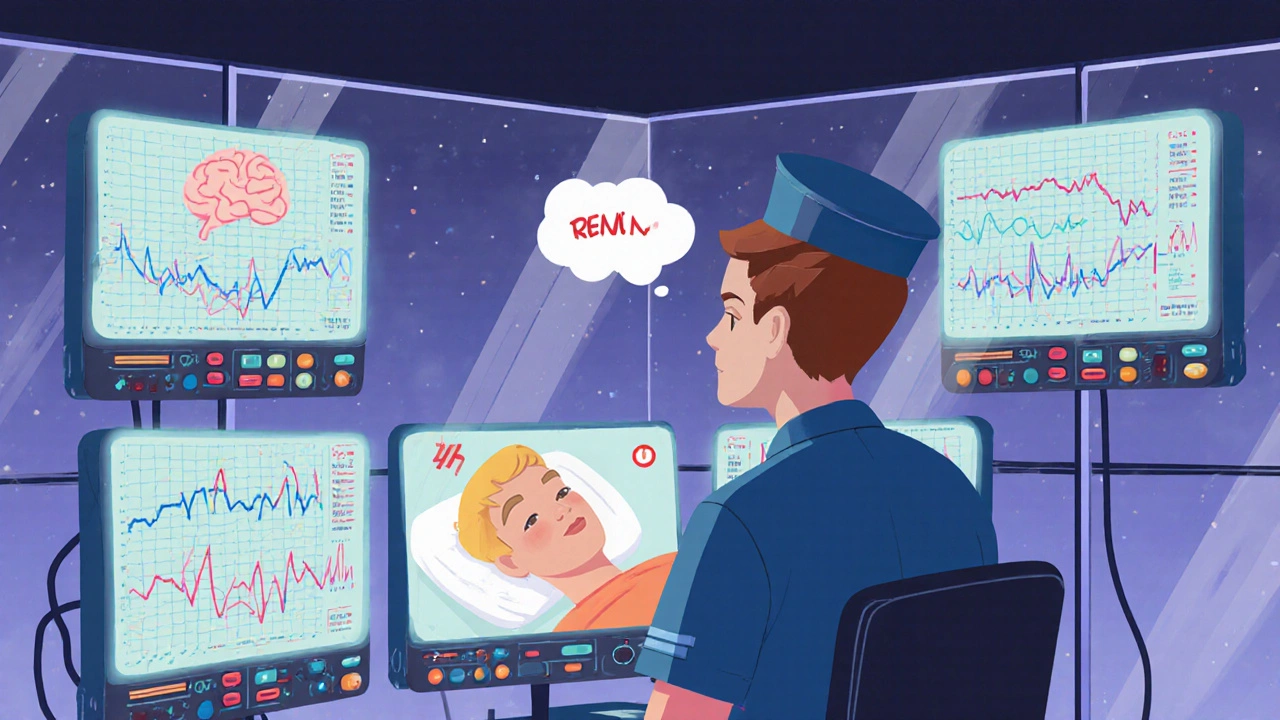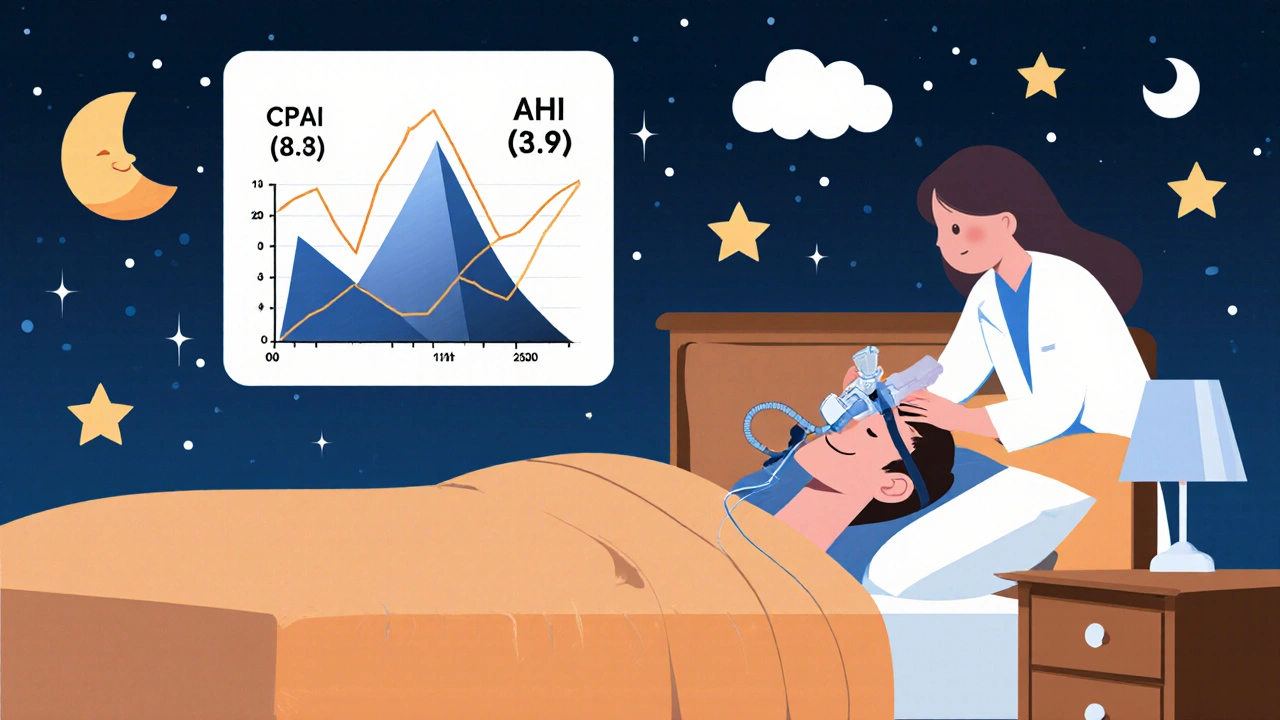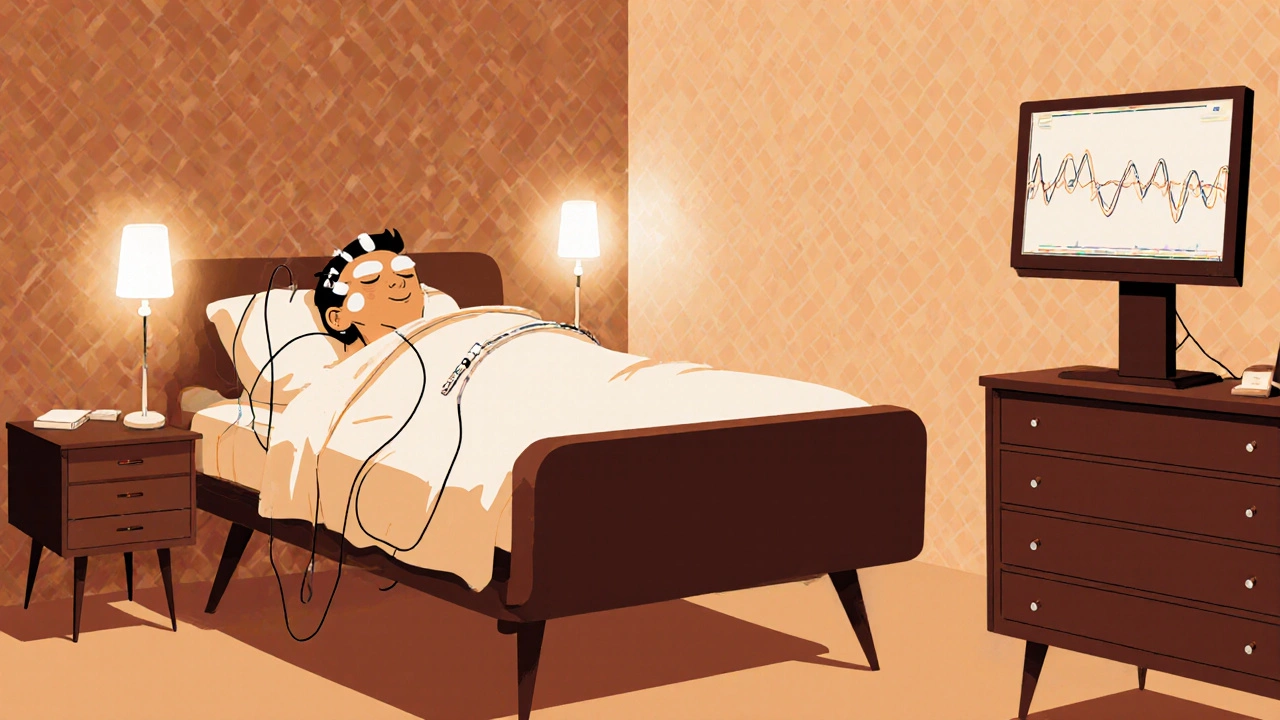If you’ve been told you need a polysomnography sleep study, you’re not alone. Over 1.5 million people in the U.S. undergo this test every year, and most of them are trying to figure out why they’re exhausted all the time - even after a full night’s sleep. Maybe you snore loudly, wake up gasping, or feel like you never really rest. Polysomnography isn’t just another test. It’s the most detailed way doctors can see what’s really happening in your brain and body while you sleep.
What Exactly Is a Polysomnography Test?
Polysomnography - often called a sleep study - is a full-night monitoring session that records at least seven key body functions as you sleep. Unlike a simple home test that only checks your breathing, this test watches your brain waves, eye movements, heart rhythm, muscle activity, oxygen levels, chest motion, and airflow. All of it. That’s why it’s the gold standard for diagnosing more than just sleep apnea. It can catch narcolepsy, restless legs syndrome, night terrors, and even seizures that happen only during sleep.
The name itself tells you what it does: "poly" means many, "somno" means sleep, and "graphy" means recording. So it’s literally a multi-parameter sleep recording. You’ll have around 22 small sensors attached to your scalp, face, chest, legs, and fingers. None of them are needles. They’re just sticky patches and bands that pick up signals. The room is quiet, dimly lit, and kept between 68-72°F - warm enough to feel cozy, not too hot or cold.
What Happens During the Night?
You’ll arrive at the sleep center about an hour before your usual bedtime. A sleep technologist will help you get settled. They’ll clean your skin, apply the sensors, and connect them to a small box you can wear on your belt. The wires are long enough that you can turn over, sit up, or even go to the bathroom without pulling anything loose.
Once you’re ready, the lights go out. The technologist watches your sleep in real time from a nearby room on monitors. They can talk to you through an intercom if you need help. If a sensor falls off, they’ll fix it. If you’re too hot or cold, they’ll adjust the room. Most people are nervous at first - the wires feel strange, the room feels unfamiliar. But by the second hour, most fall asleep. Studies show 85% of patients get enough sleep for the test to work.
Throughout the night, the machine records everything. Your brain cycles between light sleep, deep sleep, and REM sleep - the stage where you dream. In a healthy person, it takes about 90 minutes to reach REM. In someone with narcolepsy, they might jump straight into REM. In someone with sleep apnea, their breathing stops dozens of times, their oxygen drops, and their brain wakes them up - often without them remembering it.
How Is It Different From a Home Sleep Test?
Home sleep tests are cheaper and more convenient. But they only measure 3-4 things: breathing effort, airflow, oxygen levels, and heart rate. That’s fine if you’re a middle-aged man with loud snoring and daytime sleepiness - the classic signs of obstructive sleep apnea. But if you’re a woman with fatigue and brain fog, or a young adult who suddenly collapses during the day, or someone who acts out their dreams - those tests won’t catch it.
Polysomnography can tell the difference between obstructive sleep apnea (where you’re trying to breathe but your airway is blocked) and central sleep apnea (where your brain stops telling your lungs to breathe). It can spot leg jerks that wake you up every 30 seconds. It can catch sleepwalking, night terrors, or seizures that look like nightmares. Home tests miss all of that. And about 1 in 5 home tests fail - meaning you have to come in for a full study anyway.
What Do the Results Show?
After your sleep, the data is reviewed by a board-certified sleep doctor. They’ll look at how many times your breathing stopped (apneas), how low your oxygen dropped, how long you spent in each sleep stage, how often your heart skipped or raced, and whether your muscles moved abnormally.
The key numbers they focus on:
- AHI (Apnea-Hypopnea Index): How many breathing pauses per hour. Less than 5 is normal. 5-15 is mild sleep apnea. 15-30 is moderate. Over 30 is severe.
- Oxygen desaturation: How much your blood oxygen drops. Normal is above 90%. Below 85% for long periods is a red flag.
- Sleep efficiency: How much of your time in bed was actual sleep. Below 85% suggests poor sleep quality.
- REM latency: How long it took to reach REM sleep. If it’s under 15 minutes, it could mean narcolepsy.
- Leg movements: More than 5 per hour during sleep may indicate restless legs or periodic limb movement disorder.
These numbers don’t just label a condition - they guide treatment. If your AHI is 25 and your oxygen drops below 80%, you’ll likely be prescribed CPAP. If your brain waves show sudden REM onset, you might need medication for narcolepsy. If your EMG shows violent kicking during REM, you could have REM sleep behavior disorder - which can be dangerous if you’re acting out dreams.

What If You Can’t Sleep in the Lab?
It’s common to worry about this. You’re not sleeping in your own bed. There are wires. The room is unfamiliar. But you don’t need a perfect night. Even 4-5 hours of sleep with enough data is often enough for a diagnosis. The technologist will note if you slept less than usual - and the doctor will take that into account.
Some centers now use wireless sensors, cutting the number of wires from 20+ down to just 5-7. That helps a lot. You can also ask for a private room, bring your own pillow, or request a light snack before bed. Most labs let you shower in the morning and leave without the wires on - no sticky residue left behind.
Split-Night Studies: One Night, Two Purposes
If your sleep study shows severe sleep apnea early in the night - say, more than 30 apneas per hour - the technologist may switch you to a CPAP machine for the second half of the night. This is called a split-night study. Instead of coming back for another test, you get your treatment started the same night.
About 35% of polysomnography studies today are split-night. It saves time, money, and frustration. The doctor adjusts the CPAP pressure while you sleep, watching your breathing improve in real time. By morning, you know exactly what pressure you need.
Who Needs This Test?
You might be referred for polysomnography if you have:
- Loud, chronic snoring with pauses in breathing
- Daytime sleepiness that doesn’t go away with more sleep
- Waking up gasping or choking
- Unexplained fatigue, brain fog, or mood swings
- Restless legs that wake you up
- Acting out dreams - yelling, punching, kicking
- Sudden collapses or sleep attacks during the day
- High blood pressure that won’t respond to medication
It’s not just for older adults. Teenagers with ADHD, athletes with poor recovery, shift workers, and women going through menopause all benefit from this test. The American Academy of Sleep Medicine says it’s the only way to accurately diagnose many sleep disorders - and insurance companies agree. Medicare and most private insurers cover it if your doctor documents clear symptoms.

What Happens After the Test?
You’ll get your results in 1-2 weeks. The report isn’t just a list of numbers. It’s a story. It explains how your sleep architecture changed, what triggered your breathing problems, and whether your brain was properly cycling through restorative stages.
Your doctor will sit down with you and explain what it means. If you have sleep apnea, you’ll learn about CPAP, oral appliances, or lifestyle changes. If you have narcolepsy, you might start medication. If you have periodic limb movements, iron levels or dopamine drugs might help. The goal isn’t just to name the problem - it’s to fix it.
And if the test comes back normal? That’s valuable too. It means your fatigue isn’t from a sleep disorder. Maybe it’s stress, depression, anemia, or thyroid issues. Now your doctor can look elsewhere.
What’s New in Sleep Studies?
Technology is making polysomnography less invasive. Wireless sensors are becoming standard. AI tools now help analyze the massive amount of data - spotting patterns humans might miss. Some labs are testing portable versions that could one day be used at home with medical oversight. But for now, nothing beats the full in-lab study when you need a clear, complete picture.
The American Academy of Sleep Medicine updated its standards in 2020 to make sure every lab follows the same rules. That means your results are reliable - whether you’re tested in Manchester, Miami, or Minneapolis.
Final Thoughts
A polysomnography test isn’t fun. But it’s one of the most powerful tools we have to understand why you’re tired. It turns guesswork into facts. It turns "I just need more sleep" into "I have sleep apnea and here’s how to fix it."
If you’ve been living with unexplained fatigue, snoring, or strange nighttime behaviors - don’t ignore it. Sleep isn’t just rest. It’s repair. And if your body isn’t getting the right kind of sleep, nothing else will fix it.


Lashonda Rene
November 10, 2025 AT 08:18i just got back from my sleep study last week and honestly i was so nervous i thought i’d be wide awake all night but like… i fell asleep before the tech even finished hooking up the last wire? weird right? the room was cozy, my pillow was soft, and the lady kept checking in like a gentle grandma. i thought the wires would feel like a sci-fi torture device but they were just little sticky dots and bands. my brain was doing all this crazy stuff while i was out and i didn’t even know it. now i know why i wake up gasping and feel like i’ve been run over by a truck every morning. turns out i’ve got mild sleep apnea. no biggie, they gave me a cpap machine and now i’m actually sleeping. who knew the cure for exhaustion was just… breathing right?
Andy Slack
November 10, 2025 AT 17:35This is life-changing info. If you’re tired all the time and think it’s just ‘life’ - stop. Get tested. Your future self will thank you.
Rashmi Mohapatra
November 11, 2025 AT 02:26lol so many people in india are too poor to even get a good mattress, let alone a sleep study. we just say ‘jugaad’ and drink chai all day. but hey, if you got money and sleep problems, go nuts. i bet half these tests are just for rich folks to feel like they’re doing something. my uncle snores like a chainsaw and he’s fine. he just sleeps on the floor now. problem solved.
Brad Seymour
November 11, 2025 AT 21:43Really appreciate how thorough this is. I’ve been pushing my partner to get tested for months and this article finally convinced her. The part about women being misdiagnosed because symptoms don’t match the ‘classic’ male profile? Huge. So many doctors still think sleep apnea = snoring dude who’s overweight. It’s 2025. We need better awareness. Also, the split-night thing? Genius. Why make people come back? Efficiency with empathy. Nice work.
Malia Blom
November 12, 2025 AT 00:40Let’s be real - this whole polysomnography thing is just a money grab disguised as science. You’re hooked up to 22 sensors, told to sleep in a weird room, and then charged $5,000 for someone to tell you ‘you breathe weird.’ Meanwhile, my cousin just started sleeping on his side and his snoring stopped. No wires. No machines. No insurance paperwork. Also, ‘REM latency’? That’s just fancy talk for ‘you dream too fast.’ And don’t get me started on CPAP - it’s like wearing a face vacuum while you sleep. Half the people who get it quit after a week. So yeah, great article. But maybe the real problem is we’ve turned sleep into a medical industry product instead of a natural thing humans have done for millennia.
Erika Puhan
November 12, 2025 AT 06:56It’s fascinating how the medical-industrial complex has weaponized sleep science to monetize human biology. The AHI metric? Arbitrary. Oxygen desaturation thresholds? Politically negotiated. And let’s not forget the CPAP industry’s lobbying power - which is why every doctor reflexively prescribes it, even when behavioral interventions like positional therapy or weight loss could be equally effective. This isn’t medicine. It’s algorithmic capitalism dressed in lab coats. Also, ‘sleep efficiency’? That’s just a euphemism for ‘you’re not sleeping enough because you’re too stressed from capitalism.’
Edward Weaver
November 12, 2025 AT 15:32Why do we even need all this fancy tech? In my country, we just sleep. No wires, no machines, no overpriced labs. If you’re tired, you’re lazy. If you snore, you’re fat. If you collapse during the day, you’re not trying hard enough. This whole ‘sleep study’ culture is just another way Americans turn basic biology into a $$$ problem. We don’t need AI analyzing brain waves - we need people to stop eating junk food and go to bed at a normal hour. This is what happens when you let doctors run everything. Fix your lifestyle, not your sensors.